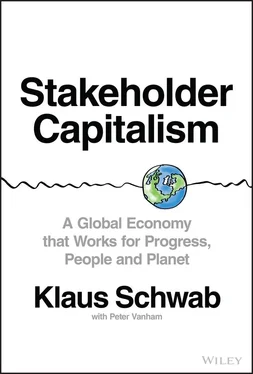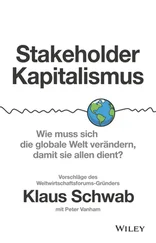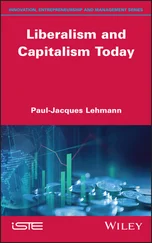Klaus Schwab - Stakeholder Capitalism
Здесь есть возможность читать онлайн «Klaus Schwab - Stakeholder Capitalism» — ознакомительный отрывок электронной книги совершенно бесплатно, а после прочтения отрывка купить полную версию. В некоторых случаях можно слушать аудио, скачать через торрент в формате fb2 и присутствует краткое содержание. ISBN: , Жанр: economics, на английском языке. Описание произведения, (предисловие) а так же отзывы посетителей доступны на портале библиотеки ЛибКат.
- Название:Stakeholder Capitalism
- Автор:
- Жанр:
- Год:неизвестен
- ISBN:9781119756149
- Рейтинг книги:4 / 5. Голосов: 1
-
Избранное:Добавить в избранное
- Отзывы:
-
Ваша оценка:
- 80
- 1
- 2
- 3
- 4
- 5
Stakeholder Capitalism: краткое содержание, описание и аннотация
Предлагаем к чтению аннотацию, описание, краткое содержание или предисловие (зависит от того, что написал сам автор книги «Stakeholder Capitalism»). Если вы не нашли необходимую информацию о книге — напишите в комментариях, мы постараемся отыскать её.
Individual agency:
A clearly defined social contract:
Planning for future generations:
Better measures of economic success: Stakeholder Capitalism: A Global Economy that Works for Progress, People and Planet
Stakeholder Capitalism
Stakeholder Capitalism — читать онлайн ознакомительный отрывок
Ниже представлен текст книги, разбитый по страницам. Система сохранения места последней прочитанной страницы, позволяет с удобством читать онлайн бесплатно книгу «Stakeholder Capitalism», без необходимости каждый раз заново искать на чём Вы остановились. Поставьте закладку, и сможете в любой момент перейти на страницу, на которой закончили чтение.
Интервал:
Закладка:
During the 1980s, Shenzhen became the kernel from which an entire economy grew. Following the example of Hong Kong and Singapore, Shenzhen at first specialized in low-cost, low-value manufacturing. With incomes starting at under a dollar a day, it wasn't hard to offer competitive salaries, with workers producing goods for export.
The Asian Tigers took notice and were among the first to shift their production. Taiwanese, Hong Kong, Singaporean, and Korean firms moved in, creating wholly foreign enterprises aimed at export or partly owned joint ventures with Chinese investors, which allowed them to sell products within China too.
As a result, people from all over China began flocking to the SEZs, drawn by the jobs and the allure of being part of something new and growing. From some 30,000 residents in the early 1980s, Shenzhen grew to become a fully-fledged Tier 1 city of more than ten million people, alongside Beijing, Shanghai, and Canton's capital to its northwest, Guangzhou. Gone were the days of Shenzhen as a “sleepy fishing village” next to some paddies of rice.
As the Special Economic Zones were a runaway success, the Chinese government created more of them, mostly along China's east coast. Cities such as Dalian, close to Korea and Japan, and Tianjin, the main port city serving Beijing (and both now home to the World Economic Forum's Summer Davos meetings) as well as Fuzhou, home to many Chinese emigrants to Singapore, were added in 1984. In 1990, Shanghai's Pudong district was added, and another few dozen SEZs followed.
The export model functioned as a catalyst. Hundreds of millions of people moved to the coastal SEZs, confident that better salaries in factories, construction firms, or services awaited them there. China's cities exploded, and its rural hinterland emptied. Annual economic growth rates reached peaks of 10 percent and more. China grew from a poor country with a GDP of $200 billion in 1980, to a lower-middle-income one, with a GDP six times that size ($1.2 trillion in 2000).
As China embarked on its Reform and Opening-Up economic policies, some inside and outside the country also hoped its political process would change, similar to what happened in the Soviet Union and its sphere of influence, including Poland, Hungary, Czechoslovakia, East Germany, and of course, Russia itself. But while this movement in Europe eventually led to the disintegration of the regime and the birth of new, democratic ones, the Chinese government maintained its central role in political and economic affairs. The 1990s became boom years for China, as many Western companies moved production there, boosting employment, pay, and consumption.
By 2001, China had grown so much and become such an export powerhouse that the time felt right to enter the World Trade Organization (WTO), which fueled yet another wave of export-led growth. Western companies, which had previously been wary or simply unaware of the possibility of manufacturing in China, now also followed suit. American, European, and Japanese companies were among the prime clients of Chinese and Taiwanese manufacturers or creating their own joint ventures.
But China's original star performer didn't stand still. As time went by, the profile of Shenzhen's industrial activities changed. Known for cheap electronics manufacturing and homegrown copycat firms at first, the city became the Silicon Valley of hardware and the home to the “maker movement of technology,” as Wired put it. 118Start-up entrepreneurs from all over China, and increasingly the world, started to meet and exchange ideas in Shenzhen, building new and innovative companies along the way.
Today, many foreign companies still have massive manufacturing bases in Shenzhen. The most famous facilities may be those of Foxconn, a Taiwanese electronics company that employs a few hundred thousand employees and produces the bulk of Apple's iPhones (or at least it did so until recently, when geopolitical concerns forced “a quiet and gradual production shift by Apple away from China,” including to a newly built Foxconn facility in India 119). It is just one of many Taiwanese and Hong Kong companies that provided the backbone of Shenzhen's early industrial expansion and still have a major footprint there.
But Shenzhen may now be better known for its homegrown technology companies. Huawei, for example, is the single largest manufacturer of telecommunications equipment in the world, making hardware to power entire fifth generation (5G) mobile networks. It also produces smartphones that can be found all over the world (except the US), though the recent trade war between China and the US has put a break on its expansion.
Huawei's success was a long time coming. In 1983, its founder, Ren Zhenfei, was just one of many immigrants trying his luck as a worker in the blossoming Shenzhen electronics industry, after a career in the Chinese army. Four years later, he founded Huawei, a small firm doing contract work for a Hong Kong equipment dealer. The story of the company's rise in the following 30 years in many ways reflects that of China as a whole.
There are many more such examples of Shenzhen start-up success (years of founding in Shenzhen are shown in parentheses):
● ZTE (1985):Producer of a variety of telecom equipment, including phones.
● Ping An Insurance (1988):China's largest insurance company and a major player in artificial intelligence. It now has 200 million customers, almost 400,000 employees, and posted $160 billion in revenue. 120
● BYD (1995):Short for “Build Your Dreams,” BYD is now the world's biggest manufacturer of electric vehicles (EVs), according to Bloomberg, “selling as much as 30,000 pure EVs or plug-in hybrids in China every month.” 121
● Tencent (1998):A technology conglomerate that owns the popular Chinese social media app QQ, a large share in e-commerce website JD.com, and the developer of the popular game “League of Legends.” It was founded by a group of Shenzhen residents, including current CEO, Pony Ma. It is the world's largest gaming company and one of its biggest social media and e-commerce players.
Shenzhen long ago stopped being a cheap manufacturing base, but it is still the southern star for China's development, which has entered an entirely new phase. After an era in which it was the factory of the world, China has turned the page. It is the second-largest economy in the world now, and the magnetic pole for many Asian and other emerging markets’ economies.
In this phase, SEZs with their focus on export continue to play a significant part. But they are increasingly eclipsed by new types of pilot zones: those of science parks, start-up incubators, and innovation hubs. There, tech start-ups and innovators are incubating products for China's increasingly tech-savvy and wealthy consumers and businesses. Shenzhen again is a leader in this field, but other locations, including Beijing's Zhongguancun neighborhood in the Haidian district (where ByteDance, the creator of TikTok, was launched), Shanghai's Zhangjiang hi-tech zone, and others are also contenders.
The Price of Progress
If you cross the Sham Chen River today, you enter a concrete jungle, the sprawling metropolis that is Shenzhen. But on a hot day in summer, you will hardly see more people in the street than you might have in the sleepy fishing village that preceded it. In part because of global warming, summer temperatures are now often so high that it's impossible to walk in the city without breaking a sweat. Instead, people have moved underground. They get around through the air-conditioned halls of Link City, an underground commercial street, or they stay in the cooled offices of the city's many skyscrapers. At other times, Shenzhenites suffer from flash floods, 122another phenomenon that has gotten worse as climate change has intensified. The city has gotten wealthy, but all its wealth could not save it from the forces of nature.
Читать дальшеИнтервал:
Закладка:
Похожие книги на «Stakeholder Capitalism»
Представляем Вашему вниманию похожие книги на «Stakeholder Capitalism» списком для выбора. Мы отобрали схожую по названию и смыслу литературу в надежде предоставить читателям больше вариантов отыскать новые, интересные, ещё непрочитанные произведения.
Обсуждение, отзывы о книге «Stakeholder Capitalism» и просто собственные мнения читателей. Оставьте ваши комментарии, напишите, что Вы думаете о произведении, его смысле или главных героях. Укажите что конкретно понравилось, а что нет, и почему Вы так считаете.












